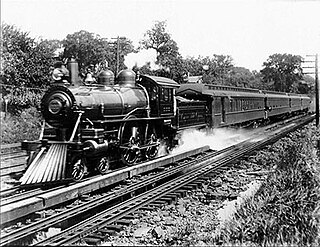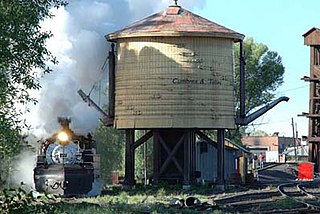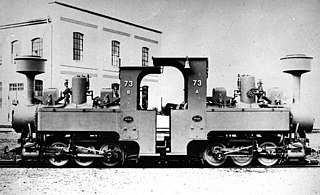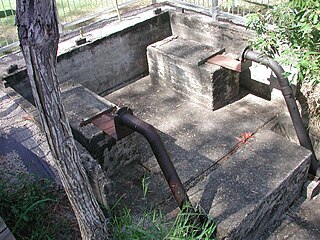
A steam locomotive is a rail vehicle that provides the force to move itself and other vehicles by means of the expansion of steam. It is fuelled by burning combustible material to heat water in the locomotive's boiler to the point when it becomes gaseous and its volume increases 1,700 times. Functionally, it is a steam engine on wheels.

Mason Bogie locomotives are a type of articulated steam locomotive suited for sharp curves and uneven track, once commonly used on narrow gauge railways in the United States of America. The design is a development of the Single Fairlie locomotive.

The Shay locomotive was a widely used North-American geared steam locomotive. The locomotives were built to the patents of Ephraim Shay, who has been credited with the popularization of the concept of a geared steam locomotive. Although the design of Ephraim Shay's early locomotives differed from later ones, there is a clear line of development that joins all Shays. Shay locomotives were especially suited to logging, mining and industrial operations and could operate successfully on steep or poor quality track.

The Mallet locomotive is a type of articulated steam railway locomotive, invented by the Swiss engineer Anatole Mallet (1837–1919).

A tank locomotive or tank engine is a steam locomotive that carries its water in one or more on-board water tanks, instead of a more traditional tender. Most tank engines also have bunkers to hold fuel; in a tender-tank locomotive a tender holds some or all of the fuel, and may hold some water also.

A tender or coal-car is a special rail vehicle hauled by a steam locomotive containing its fuel and water. Steam locomotives consume large quantities of water compared to the quantity of fuel, so their tenders are necessary to keep them running over long distances. A locomotive that pulls a tender is called a tender locomotive. Locomotives that do not have tenders and carry all their fuel and water on board the locomotive itself are called tank locomotives.

A water trough, or track pan is a device to enable a steam locomotive to replenish its water supply while in motion. It consists of a long trough filled with water, lying between the rails. When a steam locomotive passes over the trough, a water scoop can be lowered, and the speed of forward motion forces water into the scoop, up the scoop pipe and into the tanks or locomotive tender.

Under the Whyte notation for the classification of steam locomotives, 4-8-4 represents the wheel arrangement of four leading wheels on two axles, eight powered and coupled driving wheels on four axles and four trailing wheels on two axles. The type was first used by the Northern Pacific Railway, and initially named the Northern Pacific, but railfans and railroad employees have shortened the name since its introduction. It is most-commonly known as a Northern.
Rail terminology is a form of technical terminology. The difference between the American term railroad and the international term railway is the most significant difference in rail terminology. There are also others, due to the parallel development of rail transport systems in different parts of the world.

A steam shovel is a large steam-powered excavating machine designed for lifting and moving material such as rock and soil. It is the earliest type of power shovel or excavator. Steam shovels played a major role in public works in the 19th and early 20th century, being key to the construction of railroads and the Panama Canal. The development of simpler, cheaper diesel-powered shovels caused steam shovels to fall out of favor in the 1930s.

The motive power depot is the place where locomotives are usually housed, repaired and maintained when not being used. They were originally known as "running sheds", "engine sheds" or, for short, just sheds. Facilities are provided for refuelling and replenishing water, lubricating oil and grease and, for steam engines, disposal of the ash. There are often workshops for day to day repairs and maintenance, although locomotive building and major overhauls are usually carried out in the locomotive works.

Crewe Diesel Depot is a former diesel-electric locomotive traction maintenance depot – formerly Crewe Diesel Traction Maintenance Depot or Crewe Diesel TMD - situated to the south of and visible from Crewe railway station. Built in 1958 by British Railways it was used as a maintenance facility for the diesel locomotives that were at the time replacing steam traction across the national rail network. Following the privatisation of British Rail depot ownership transferred to EWS, now DB Schenker and continued as a base for diesel traction, latterly becoming a facility for storing surplus rolling stock. In 2014 ownership transferred to Locomotive Storage Limited who have been and are continuing to renovate the site.

A water stop or water station on a railroad is a place where steam trains stop to replenish water. The stopping of the train itself is also referred to as a "water stop". The term originates from the times of steam engines when large amounts of water were essential. Also known as wood and water stops or coal and water stops, since it was reasonable to replenish engines with fuel as well when adding water to the boiler.

A Triplex locomotive is a steam locomotive that divides the driving force on its wheels by using three pairs of cylinders rigidly mounted to a single locomotive frame. Inevitably any such locomotive will be articulated. All the examples that have been produced have been of the Mallet type but with one extra set of driving wheels under the tender.

The South West African Zwillinge 0-6-0T of 1898 was a narrow gauge steam locomotive from the German South West Africa era.

The Beaumont St. Louis and San Francisco Railroad Water Tank is a railroad water tank constructed in 1875, in Beaumont, Kansas. It served the St. Louis, Wichita & Western Railway, and was used to refill the boilers of steam locomotives on that line. It was added to the National Register of Historic Places in 1993.

The Cape Government Railways Fairlie 0-6-0+0-6-0 of 1876 was a South African steam locomotive from the pre-Union era in the Cape of Good Hope.

Murphys Creek Railway Complex is a heritage-listed railway yard on the Main Line railway at Odin Street, Murphys Creek, Queensland, Australia. It was built from 1921 to c. 1949. It is also known as Murphys Creek Locomotive Water Tank & Tower. It was added to the Queensland Heritage Register on 24 September 1999.

Lagoon Creek Pumping Station is a heritage-listed pumping station at Buckle Street, Caboolture, Moreton Bay Region, Queensland, Australia. It was built from 1913 to 1947. It was added to the Queensland Heritage Register on 24 January 2003.



















